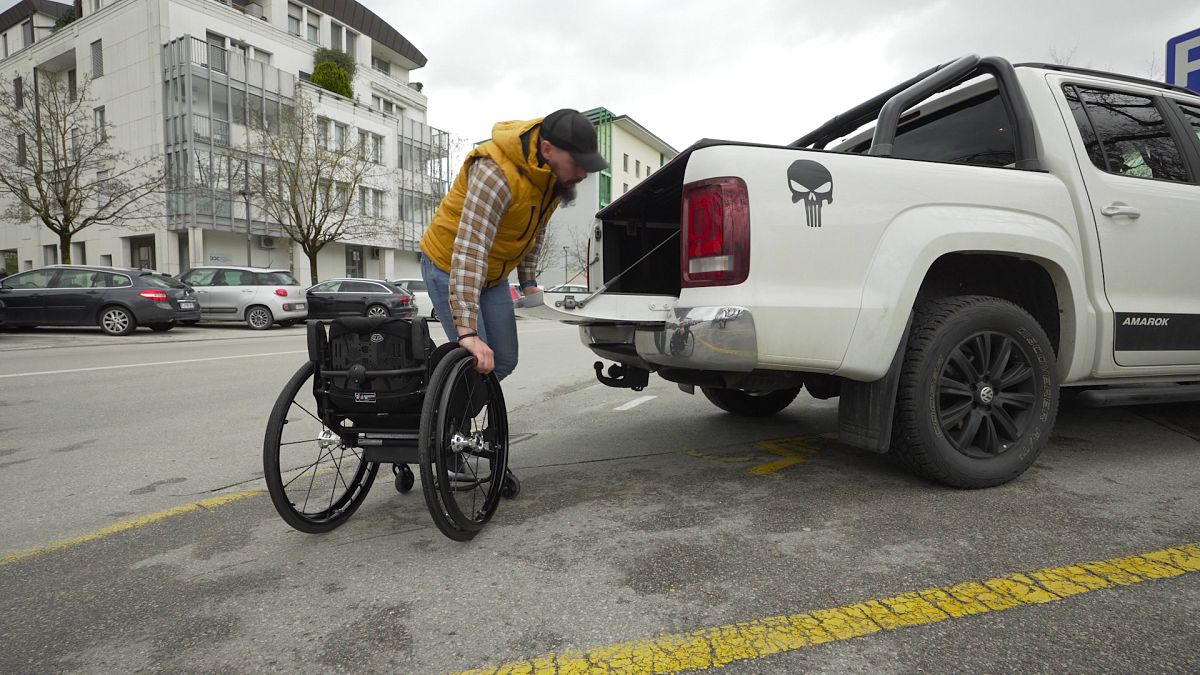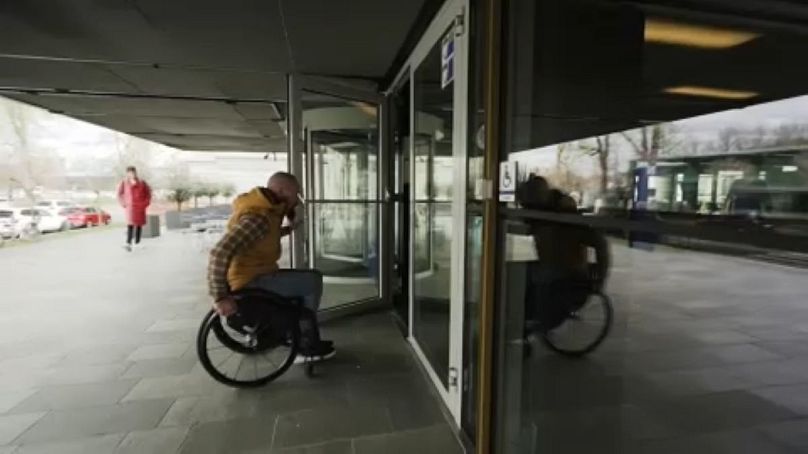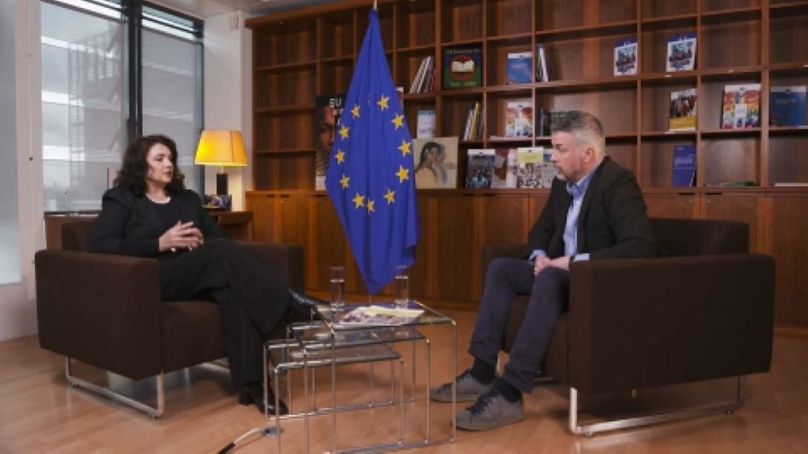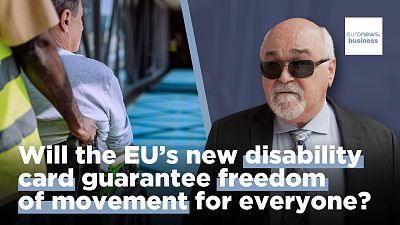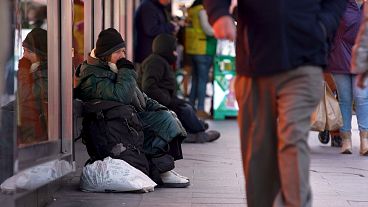In this episode of Real Economy, Euronews reporter Paul Hackett travels to Ljubljana and Brussels to learn how Europe's new disability and parking cards aim to facilitate cross-border travel and enhance accessibility for individuals with disabilities.
The right to move freely and reside within the EU is a cornerstone of European citizenship. But for many people with disabilities, while this is possible in theory, the reality is very different.
The new EU-wide European Disability Card and the updated EU parking card for people with disabilities aim to solve issues around this by enabling users to prove their disability status anywhere in the bloc.
Approximately 101 million people, or 27 per cent of EU citizens over the age of 16, have a disability according to the European statistics agency Eurostat.
Eight EU countries - Belgium, Italy, Finland, Malta, Cyprus, Estonia, Slovenia and Romania - have been piloting the European Disability Card since 2016. The trial's success led Brussels to push for a full roll-out across the bloc and on February 8 this year the European Parliament and Council reached a provisional agreement.
Lawmakers have also agreed to update the European Parking Card for Persons with Disabilities with a standardised EU design to end confusion and fraud caused by the current patchwork of national cards.
The agreed text is expected to be formally adopted by both the Parliament and Council and put to a vote in the European Parliament's final plenary session between 22-25 April.
The European Disability Forum has described the latest policy developments as a "momentous victory", but has also emphasised that they are a first step. For instance, the new rules will only apply for short stays of up to three months with an exception for disability card holders who move to another member state for a mobility programme, such as Erasmus+.
In addition, member states will have 30 months to adapt and another 12 months to formally implement the new rules, meaning it could take another three-and-a-half years for the card to be accessible across the entire EU.
“The cards are the first step. They take away some obstacles when travelling. They make it easier, but they do not allow us to enjoy the right to move, to study, to work. Disability assessment needs to happen again. Our disability does not travel with us,” Yannis Vardakastanis, the President of the European Disability Forum (EDF) told Euronews.
More than just facilitating travel
Both cards will replace national cards currently issued by local authorities. Once applied for they will be issued within ninety days in a physical or digital format except in cases when longer medical checks are required. Receipt and renewal of the European Disability Card will be free of charge except when lost or damaged.
Cardholders who travel to other EU countries will have access to discounts on local transport, assistance on trains and other public transport, reduced or zero entry fees, priority access and reserved parking.
The new rules will also cover accompanying care support personnel or care support animals. Those who do not have additional support and need more assistance can add the letter 'A' to their card, entitling them to extra help when shown.
Once a provider like a gallery or museum joins the scheme, cardholders from other participating countries get the same rights.
Živa Rogelj, the Head of Education at the National Gallery of Slovenia, explained that they are trying to make the gallery as accessible as possible, "not just free entrance for the people with disabilities but also personalised guided tours or personalised creative workshops free of charge,” she said.
Former Paralympian Primož Jeralič was left almost fully paralysed from the waist down after a skiing accident at the age of 24. Today he uses both cards.
“I have been a disabled person for about 16 years now and it was difficult, especially travelling around Europe to identify myself. Now that I am a holder of the EU Disability Card, I can be easily recognised as a disabled person,” he told Euronews.
"At the beginning, I must say I was afraid to show my disability card. But I was really surprised because this card is recognisable all around Europe. I'm travelling a lot, and I did use this card in Belgium, Italy, Austria, Croatia and Germany, all around Europe".
Possible next steps
The National Council of Disability Organizations of Slovenia (NSIOS) is calling for the two cards to be made into one to avoid any confusion with local authorities and make it less stressful for people with disabilities to travel.
“We want to build awareness among the people with disabilities. And we want to attract more providers to the card. And lastly, we hope that someday the EU card and parking card will be combined in one,” said Gašper Oblak, a representative from the NSIOS.
Pieter Paul Moen is a member of the EDC Fan Team in Belgium, a pan-European voluntary organisation striving for better inclusion for people with disabilities. Pieter has autism and told Euronews the police have sometimes mistaken his disability for drunkenness.
“We want this card to also be used by the emergency services. When you have a panic or stressful situation, you can also use this card when you are in contact with police, ambulance or hospital. You can prove his or her handicap to the doctors or the nurse in this situation,” he advised.
The EU Commissioner for Equality, Helena Dalli, explained that the card is a step towards better integration but acknowledged it does have some limitations.
"With this card, any rights which a person with a disability has in one country will be available to all the persons with disabilities visiting that particular country, so this recognition is very, very, very important.
"Of course, we have to abide by the treaties and we cannot go further than what we have done because then it is member state competence. But it is definitely an improvement on what there is now," she told Euronews.
The EDF petitioned for an EU Disability Card for more than a decade. While the organisation agrees the new rules will create greater awareness and acceptance, it argues that the cards will not make things easier for people with disabilities looking to move to another member state permanently.
The disability card excludes social security, social assistance and other residence-based social benefits. People with disabilities looking to move to another state long-term will lose their right to social security-related benefits in their home country. They may have to wait months or even years before benefits are processed in the new country of residence.
Despite that, Commissioner Dalli explained that the legislation process had been quick, "this directive I am happy to say was one of the swiftest; I mean I've never passed any legislation which went by so quickly. So that shows that member states are keen on this card, which is so important and that is going to improve so much the lives of people with disabilities.”
The EDF has also advised that the cards shouldn't be issued automatically unless a person with disabilities has requested one or explicitly agrees to have the card issued or renewed. This will ensure that there will be no obligation for people with disabilities to show the card as proof of disability for better access to services.
If you would like more information on the European Disability Card or how to get one, click on the link here. To watch the episode click on the video in the media player above.
